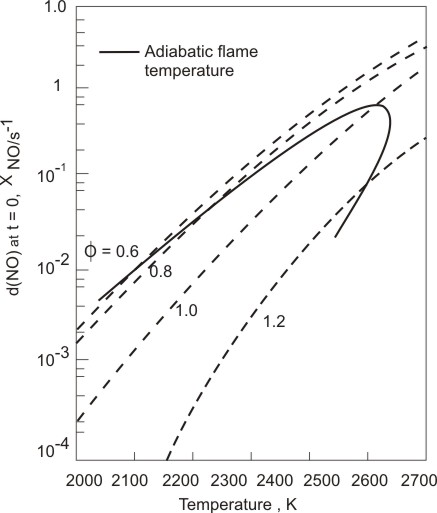Contd...
KNO is given by
and mole fraction of N2 at equilibrium, x [N2]e ≈ 0.71
From the above,
Time  is in seconds, pressure, P is in atmospheres and temperature, T is in K. is in seconds, pressure, P is in atmospheres and temperature, T is in K.

Fig. 2.4 Dependence of initial rate of NO formation on temperature and fuel-air equivalence ratio ( ). The dashed line shows adiabatic flame temperature line for different values of ). The dashed line shows adiabatic flame temperature line for different values of  . The maximum NO formation rate occurs at slightly leaner than stoichiometric mixture. . The maximum NO formation rate occurs at slightly leaner than stoichiometric mixture.
Fig. 2.4 shows the initial NO formation rate as a function of temperature for different fuel-air equivalence ratios. For a given value of  NO formation increases with temperature. And as NO formation increases with temperature. And as  is reduced more oxygen is available resulting in higher NO formation for a fixed reactant temperature. In the real combustion systems, the burned gas temperature also depends on the value of is reduced more oxygen is available resulting in higher NO formation for a fixed reactant temperature. In the real combustion systems, the burned gas temperature also depends on the value of  . On this figure, the adiabatic flame temperature for a hydrocarbon fuel-air mixture initially at 700 K and combustion at constant pressure at 15 atm for different fuel-air ratios is also shown. The adiabatic constant pressure combustion of a charge element as an acceptable model for an internal combustion engine. The initial NO formation rate is seen to be highest for a mixture slightly leaner than stoichiometric. . On this figure, the adiabatic flame temperature for a hydrocarbon fuel-air mixture initially at 700 K and combustion at constant pressure at 15 atm for different fuel-air ratios is also shown. The adiabatic constant pressure combustion of a charge element as an acceptable model for an internal combustion engine. The initial NO formation rate is seen to be highest for a mixture slightly leaner than stoichiometric.
|